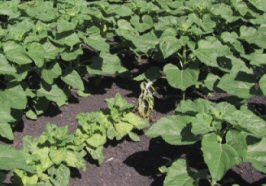Downy Mildew
Downy mildew can cause severe yield losses during wet years, especially in poorly-drained fields.

Figure 1

Figure 2
Host Crops
Sunflowers
Biology
The fungus is soil-borne, wind-borne and seed-borne. The fungus may persist in the soil for five to ten years. Under cool, water-saturated soil conditions, the spores, upon contact with sunflower roots, germinate and enter the seedling's roots and spread throughout the entire plant. When infected plants rot and are tilled into the soil, the fungus forms the resting stage. It will germinate again when conditions are favourable.
If seedlings are infected several weeks after emergence, they exhibit the typical leaf symptoms of downy mildew (Figure 2) but not the stunting that is usually associated with the disease. Plants infected after the four-leaf stage may develop a thickened, club-like root , become stunted, and show foliar symptoms (Figure 1). These plants are prone to drought stress and lodging. Mature plants are often stunted, producing normal sized heads with few if any seeds. Secondary spread of spores (ie., by wind) may result in the development of small, localized, angular chlorotic spots on the leaves. These spots may coalesce and resemble a systemic infection. However, the foliar lesions rarely produce a true systemic infection.
Symptoms Of Damage
Symptoms can be seen at all growth stages. Seedlings appear dwarfed and chlorotic (yellowed) and may have thickened, leathery leaves (Figure 1 and Figure 2). In high humidity, the undersides of leaves may be covered with white, cottony growth.
Yield losses from downy mildew can be substantial depending on the percentage of infected plants and their distribution within the field. If infected plants are scattered randomly throughout a field, yield losses probably will not be observed until infection exceeds 15% due to the compensating ability of healthy plants adjacent to infected plants. When the disease is in a localized area, such as a low spot in a field and all plants are infected, the yield loss will be much greater.
Scouting Techniques
Diseased plants are most often noticed alone or in standing water. Severely-infected plants may die before or shortly after emergence or in the seedling stage. The few plants reaching maturity seldom produce viable seed. The heads on these plants usually face straight up, making them more vulnerable to bird feeding.
Note: Dwarfing and distortion of leaves also are symptoms typical of herbicide drift damage, especially 2,4-D and related phenoxy compounds. However, herbicide damage never exhibits the white appearance (fungal growth) on the underside of the leaves nor the chlorosis typical of downy mildew.
Economic Thresholds
None available.
Control Tips
- Use resistant varieties. Many commercial hybrids are resistant to several but not all races of downy mildew. Use an extended crop rotation of four years between sunflower crops.
- Do not seed sunflowers in lowlands that flood frequently and maintain high inoculum levels from alternate hosts.
- Control volunteer sunflower. Delay planting until soil temperatures favour rapid seedling growth.
- Use a fungicide seed treatment to protect against root infection. The seed treatment does not protect against foliar infection.

